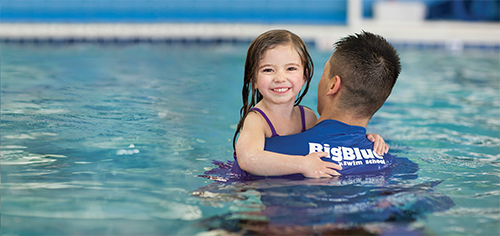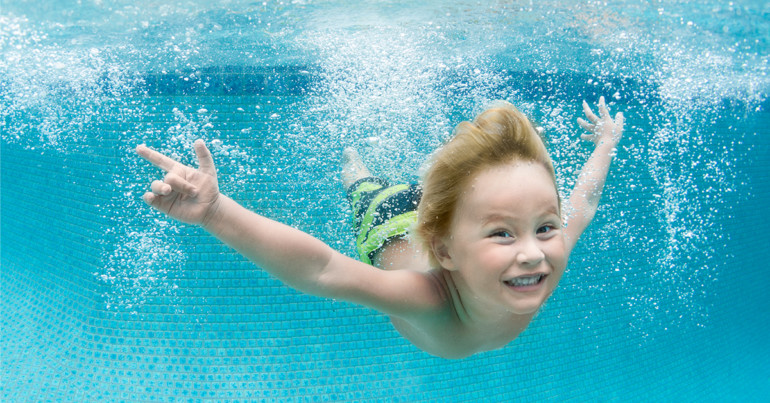The scary truth is even an experienced swimmer can drown. Here’s how to make sure your family is ready for a safe summer of fun in the water.
Picture this: The sun is shining, the kids are splashing around in the pool and you’re relaxing nearby in a patio chair.
With summer here, this scene isn’t a far-off fantasy. Though fun in the sun is supposed to be just that — fun — it’s never too early to start planning for your family’s safety at the pool, the beach or the waterpark.
It’s scary to think about, but even the calmest water can be a source of danger. In 2015, the most recent year for which data is available, the Centers for Disease Control and Prevention recorded 105 unintentional drowning deaths in Illinois. Nationally, that number was 3,602. Those numbers don’t account for non-fatal drownings, either, which can cause permanent injuries.
Water is even more risky for young children. Other than birth defects, drowning is the leading cause of death for children ages 1 to 4, according to the CDC.

These statistics are alarming, but experts say drowning is completely preventable, if you know what steps to take to protect yourself and your family.
First, it’s important to remember that no one is immune to drowning, not even the best swimmers. That’s why it’s important to have layers of protection in place, according to Alissa Magrum, executive director of Colin’s Hope, a nonprofit that started after the 2008 drowning death of 4-year-old Colin Holst.
“Drowning has no boundaries,” Magrum says. “It’s something that can impact anyone. No one is drown-proof. Sometimes we have a hard time because people think, ‘Oh, this isn’t going to happen to me. This is somebody else’s kid. My kids know how to swim. We’ve been around water all of our lives.’”
Swimming ability is just one aspect of water safety, albeit an important one. It’s never too early — or too late — to take formal swimming lessons, says John Fitzpatrick, head coach of the Chicago Blue Dolphins, which offer lessons for infants, adults and every age in between.
You don’t have to be Michael Phelps to swim to safety during an emergency. Take it slow and start with the basics, such as being able to float comfortably or get to the wall or a ladder.
“There used to be a strategy in gym classes or swim instruction that since we all came from the womb, we’re all natural swimmers so just throw the kid in the deep end and they’ll figure it out,” Fitzpatrick says. “But you never want to ingrain fear into a person’s learning process. You want to start in shallow water and you want to go at the swimmer’s pace.”

Beyond learning how to swim, here are steps you can take to keep your family safe at the pool or the beach this summer.
- Remember that drowning is silent and quick. “Drowning is not like in the movies,” says Ellyn Pollack, a spokeswoman for the U.S. Consumer Product Safety Commission, which launched its Pool Safely campaign in 2010. “They’re not splashing and screaming for help.”
- There should be several barriers and safety mechanisms in place for at-home pools and spas. Invest in a pool cover with an alarm, a four-sided fence around the pool and a self-closing, self-latching gate, says Pollack. Your fence should be at least four feet high and not climbable.
- Designate a water guardian, or an adult whose eyes never leave the pool — not even for a second. If the water watcher has to make a phone call or run to the restroom, it’s a good idea to pass off that duty to someone else. “You often see drownings occur at backyard pool parties where there are a lot of adults around — there may even be lifeguards on duty — but everybody thinks someone else is watching or they think they’re going to hear something,” says Magrum.
- If you or another adult will be spending a lot of time near water this summer, consider learning CPR. “It’s another tool to have in your toolbox,” Magrum says.
- Arm floaties are no substitute for life jackets in open water. Magrum recommends that both children and adults wear U.S. Coast Guard-approved life jackets at all times while boating, stand-up paddleboarding or swimming in open water.
- Your child won’t always be with you while swimming or near water. Consider talking with anyone who will be caring for your child, such as a babysitter, a camp director or the parents of your child’s friends about water safety precautions, Magrum says.
- Teach your children to stay away from pool drains, even if they’re properly covered. “Hair can get entrapped, bathing suits can get entrapped,” Magrum said. As an adult, familiarize yourself with pool functions so you know how to shut the drain off during an emergency.
- For very young children, an adult should always be in contact with the child in the water. For older children, an adult should always be an arm’s length away, says Fitzpatrick.
- Always wear your life jacket on a boat — it will likely make the difference between life and death if you’re involved in a boating accident, says Rachel Johnson, executive director of the National Safe Boating Council.
- Never drive a boat while under the influence of alcohol or other drugs. “Alcohol use was the leading known contributing factor in fatal boating accidents in 2015,” Johnson says.
- Consider enrolling your family, including your kids, in a boating safety course before you head out on the water, Johnson says.
- Don’t rely solely on lifeguards. Though they’re water safety experts, they’re tasked with watching hundreds of swimmers at a time and their vision may be affected by the glare of the sun, children splashing or pool floaties. “Lifeguards are not babysitters,” says Chris DeJong, founder of the Big Blue Swim School, which has donated 7,300 swimming lessons to at-risk youth through the Union League Boys & Girls Clubs in Chicago. “A child should never be left alone near water — ever.”
- When looking for a swim lesson provider, ask questions to ensure your child will get quality instruction. A 2009 study conducted by researchers at the National Institute of Child Health and Human Development found that formal swimming lessons reduced the risk of drowning in children ages one to four by 88 percent. “Ask your swim lesson provider if the teachers there are encouraged to work full-time hours to pursue careers in aquatics instruction,” DeJong says.
Help the Big Blue Swim School provide free swimming lessons to at-risk youth through the Union League Boys & Girls Clubs in Chicago by visiting bigblueswimschool.com/donate.

